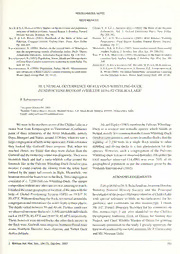
Unusual Occurrence of Fulvous Whistling duck Dendrocygna Bicolor (Vieillot 1816) At Chilika Lake PDF
Preview Unusual Occurrence of Fulvous Whistling duck Dendrocygna Bicolor (Vieillot 1816) At Chilika Lake
. MISCELLANEOUS NOTES REFERENCES AllS.&S.A.Hussain(1981):Studiesonthemovementandpopulation Cramp, S. & K.E.L. Simmons (Eds.) (1983): The BirdsoftheWestern structureofIndianavifauna.AnnualReport 1. BombayNatural Palaearctic. Vol. 3. Oxford University Press. New Delhi. History Society, Bombay. Pp.98. Pp. 268-282. Ali, S. & S.D. Ripley (1983): Handbook of the Birds of India and Daniel, J.C. & S. Balachandran (2002): Bird Banders Training Pakistan. Compact edition, Oxford Univ. Press, New Delhi. Programmes. Final Report Bombay Natural History Society, Pp. 168-169. Bombay. Pp. 27. Balachandran, S. (1990): Studies on the coastal birds ofMandapam Mohapatra,K.K. &P. Rao(1993): Somewadersrecordsfromcoastal and the neighbouring islands (Peninsular India). Ph.D. Thesis, AndhraPradesh. ./. BombayNat. Hist. Soc. 89: 250-251. Annamalai University,Annamalai Nagar, India. Pp. 138-143. Rao, P. & K.K. Mohapatra (1993): Occurrence ofthe Knot (Calidris Balachandran,S.(1997):Population,Status,MoultandMeasurements canutus) fromAndhra Pradesh. ./. BombayNat. Hist. Soc. 90: ofGreatKnotCalidristenuirostriswinteringinsouthIndia. The 509. Stilt30: 3-6. Zockler,C„S.Balachandran,GC.Bunting,M.Fanck,M.Kashiwagi, Balachandran, S. (1998): Population, Status, Moult, Measurements E.G.Lappo,G.Maheswaran,A.Sharma,E.E.Syroechkovski& andsubspeciesofKnotCalidriscanutuswinteringinsouthIndia. K.Webb(2005):TheIndianSunderbans:animportantwintering WaderStudyGroupBull. 86: 44-47. siteforSiberian waders. WaderStudyGroupBull. 108: 42-46. UNUSUAL OCCURRENCE OF FULVOUS WHISTLING-DUCK 10. DENDROCYGNA BICOLOR (VIEILLOT 1816) AT CHILIKALAKE1 P. Sathiyaselvam2 'AcceptedOctober03,2006 2BombayNaturalHistorySociety,HornbillHouse,S.B. SinghRoad,Mumbai400001,Maharashtra,India. Email: [email protected] WewereinthenorthernsectoroftheChilikaLakeina AliandRipley(1983)mentiontheFulvousWhistling- motor boat from Kaluparaghat to Tinimuhani (Confluence Duck as a resident and nomadic species which breeds in point of three tributaries of the River Mahanathi, namely Bengal,usuallylesscommonthantheLesserWhistling-Duck Daya, Bhargavi andNuna), around 1130hrs, when wesaw a Dendrocygnajavanica andoccursinsmallerflocks.Butthe , largecongregationofbirdsintheopenwater.Fromadistance sighting of 7,250 birds in a single flock similar to other they looked like Gadwall Anas strepera. But, when we dabbling and diving ducks is a rare phenomenon for this reached closer, we found that they were darker than the species. However, such a congregation of the Fulvous Gadwallandthetwitteringsoundwasdiagnostic.Theywere Whistling-duckwasneverobservedthereafter.Altogetherthe brownish black and had a rusty-whitish collar around the total number observed (14,490) was over 70% of its foreneck like in the Fulvous Whistling-Duck Dendrocygna geographical population as per the estimates given by the bicolor; I could confirm the identity from the white band Wetlands International (2002). formed by the upper tail coverts in flight. Meanwhile, our boatmanmovedtheboatclosertotheflock.Thiscongregation ACKNOWLEDGEMENTS consisted of c. 7,250 Fulvous Whistling-Duck. The unique compositionwithoutanyotherspecieswasamazingtowatch. IamgratefultoDr.S.Balachandran,AssistantDirector, Imarkedtheexactgeographical locationoftheareawiththe Bombay Natural History Society and the Principal help of Global Positioning System (GPS) as 19.83° N; Investigatoroftheproject(HabitatevaluationofChilikaLake 85.47°E.Withoutdisturbingtheflock,wemovedaroundthe with special reference to birds as bio-indicators) for his congregationanddeterminedthewaterdepthinthreeplaces. guidance and comments on this manuscript. I thank The depth variedbetween 30 and40 cm. Further south-east Mr. J.C. Daniel, Honorary Secretary for his comments on weobservedtwomoreflocksofc. 1,500and4,600individuals this manuscript. I am also thankful to the Chilika eachat 19.83°N;85.47°Eand 19.83°N;85.48°Erespectively. Development Authority, Govt, of Orissa, for funding this These,howeverweremixedflocks;theotherduckspeciesin Project, and Chief Wildlife Warden of Orissa for granting theflockwere,GadwallAnasstrepera,NorthernPintailAnas necessary permission to the study. I greatly appreciate the acuta, Northern Shoveler Anas clypeata, and Tufted Duck hardworkrenderedbyourfieldassistantsMr. P.Guruswamy Aythyafuligula and Mr. Niranjan Dalei. J. Bombay Nat. Hist. Soc., 104 (3), Sep-Dec 2007 351 MISCELLANEOUS NOTES REFERENCES Au, S. & S.D. Ripley (1983): Handbook of the Birds of India and WetlandsInternational(2002):WaterbirdPopulationEstimates.Third Pakistan.Compactedition,OxfordUniversityPress,NewDelhi. Edition. Wetlands International Global Series No. 12, pp. 139-141. Wageningen,The Netherlands. Pp. 68. COMMENTS ON THE REVIEW BYASAD RAHMANI, ON 11. •HANDBOOK ON INDIAN WETLAND BIRDS AND THEIR CONSERVATION’ 1 C. Radhakrishnan2 'AcceptedAugust08,2006 "WesternGhatsFieldResearchStation,ZoologicalSurveyofIndia, Kozhikode673002, Kerala,India. Email: [email protected] While reviewing the ‘handbook on Indian wetland The sole reference system for biodiversity interpretation is birds and their conservation’ by Kumar et al. (2005), cateredbythescienceofTaxonomy(Narendran2006).Faunal published by the Zoological Survey of India (ZSI), the documentation,includingdescribingnewspecies,aspracticed reviewer commented, “unfortunately the ZSI is also by ZSI has to follow the principles of taxonomy using the famous for bringing out boring tomes, full ofjargon and technical or specialized words particular to that branch of technical descriptions of new species which interest only science. Every branch of science uses its own recognized thesubjectexperts.Thisisnowchanging,thankstothebook terminologies, however difficult it may be for others to brought out by Dr. Arun Kumar and his team” (Rahmani understand. 2005). Ifthetaxonomicdescriptionsareboringtothereviewer, According to the Oxford Advanced Learner’s being the Executive Editor of the Journal ofthe Bombay dictionary, the word ‘tome’ means a large heavy book, NaturalHistorySociety whythereviewerprovidesasection , especially scholarly or serious one. A scholarly or serious called New Descriptions in his Journal that uses only the bookbecomesboringonlytotheilliterateignorant.Obviously, taxonomicjargon? Obviously, it is to the interest ofsubject it is tothe interest ofsubject experts only. expertsonly. Asrightly pointedoutby the reviewer, the mandate of ACKNOWLEDGEMENTS ZSIistodocumenttheanimaldiversityofthecountry. Inthe ConventiononBiodiversityof1992,andlaterinseveralnew global agreements, the message of conservation and TheauthorisgratefultotheDirector,ZoologicalSurvey sustainableuseofbiodiversityhasbeenontheprimeagenda. ofIndia, Kolkata, forfacilities andencouragement. REFERENCES Kumar,A., J.P. Sati, PC. Tak & J.R.B.Alfred(2005): Handbookof ZoologicalSurveyofIndia, Kolkata. pp. 1-80. Indian Wetland Birds and their Conservation. Director, Rahmani Asad R. (2005): A Handbook on Indian Wetlands Birds Zoological SurveyofIndia, Kolkata. pp. i-xxvi, 1-468. and their Conservation. J. Bombay Nat. Hist. Soc. 102(2): Narendran, T.C. (2006): An introduction to Taxonomy. Director, 214-215. FOOD AND FEEDING HABITS OFTHE GREEN TURTLE CHELONIA MYDAS 12. IN RELATION TO MARINE PLANTS IN THE GULF OF MANNAR BIOSPHERE RESERVE, INDIA1 P. Kannan2and M. Rajagopalan3 'AcceptedNovember 17,2005 "RegionalCentreofCentralMarineFisheriesResearchInstitute(ICAR),MandapamCamp623520,TamilNadu,India. PresentAddress: ChennaiSnakePark,Raj Bhavan(Post)600022,Chennai,TamilNadu,India.Email: [email protected] "CentralMarineFisheriesResearchInstitute,ICAR, Kochi,682018, Kerala,India. Email: [email protected] Introduction 1950;Carr 1953;JonesandFernando 1968;Agastheesapillai Green turtles are the most abundant sea turtles in the andThiagarajan 1979; Bhupathyand Saravanan 2001), they GulfofMannarand Palk Bay (Deraniyagala 1939; Kuriyan areprimarilyherbivores,feedingonavarietyofmarinealgae 352 J. Bombay Nat. Hist. Soc., 104 (3), Sep-Dec 2007
